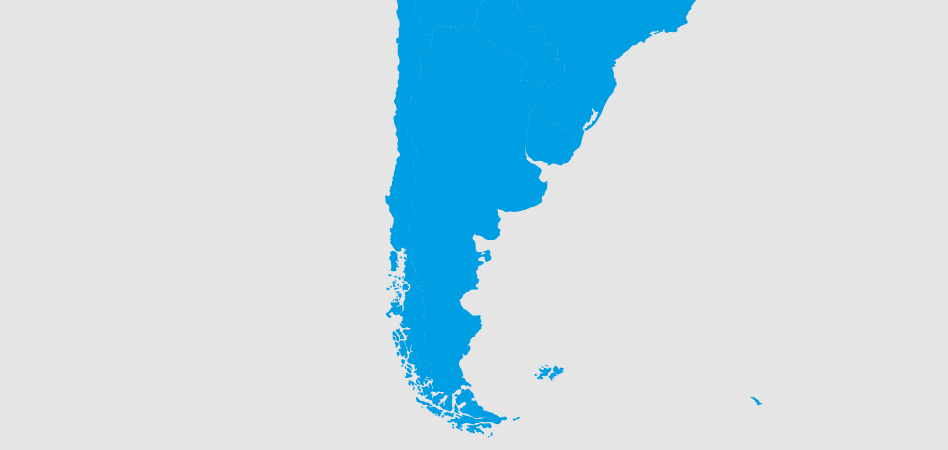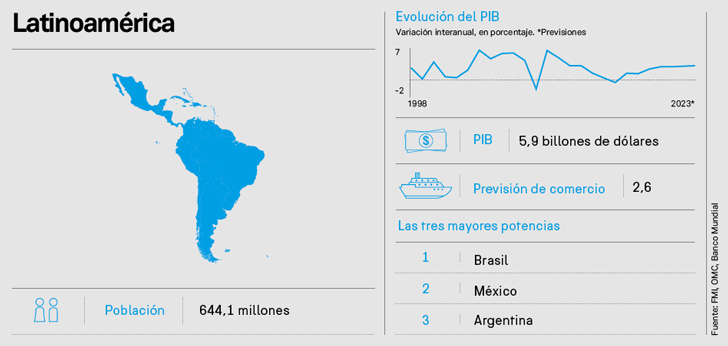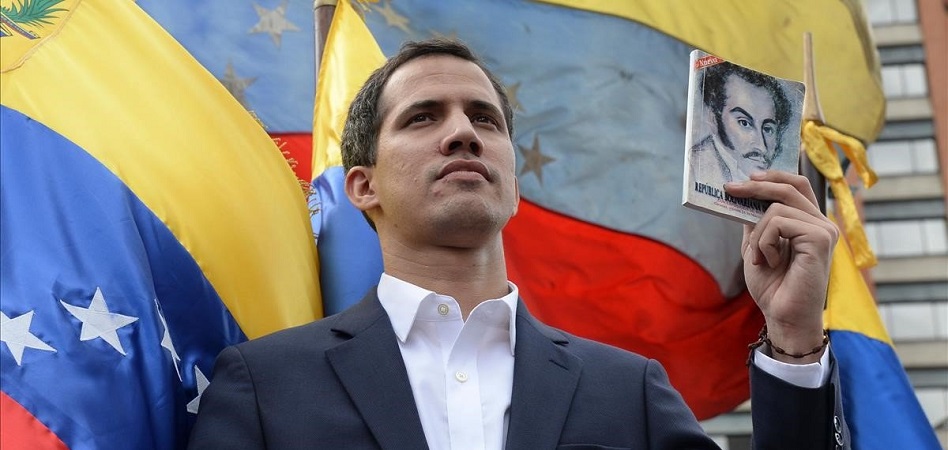A Changing World: Latin America, the ‘eternal promise’ threatened by populism
The uncertainty and the crisis in Venezuela affected the growth prospects in the region, which faces a key year after the changeover of power in Mexico and Brazil.

Fashion business’ game board has turned around. The legacy of the crisis, instability, the peak of populist movements, the attempts to move backwards in globalization and the threat of the global economic downturn has made almost all the predictions fail one by one. The world undergoes a transformation, and fashion, as a global player, must adapt and transform with it. MDS will go through the keys for the new order in the most important markets in the sector and how this can affect one of the most globalized business in the world.

Latin America is the great promise in the world. In 1914, Argentina had a Gross Domestic Product (GDP) per capita higher than that of Germany, France or Italy. Brazil was part of the BRIC, the emerging group called upon to lead the growth of the world. Mexico was one of the MINT, the economies that took over the BRIC block. Today, the region that accounts for 8% of the world's population observes how the economic centre turns to the East again, while anger and disaffection bring new populist politicians to power.
These new leaders face 2019 with big pending tasks such as inequality and insecurity, with little margin for fiscal manoeuvres and growth forecasts affected by the crisis in Venezuela.
Last week, the International Monetary Fund (IMF) lowered its growth prospects for the Latin American economy by two tenths, placing them at 2% for 2019 and 2.5% for 2020, due to the impact of the worst estimates for Mexico, the worst situation in Venezuela and the recession in Argentina.
Apart from Venezuela, the growth in Latin America and the Caribbean would be 2.3% for this year and 2.7% for 2020. The forecasts for the South American country are even more uncertain than a week ago, after Juan Guaidó self-proclaimed interim president of the country.
The United States, Argentina, Brazil, Canada, Colombia, Chile and Costa Rica have already supported the opposition, while the European Union demands Nicolás Maduro to call elections “in a matter of days”.
Beyond Venezuela, the forecasts for Latin America have also been affected by the weakening of the world economy and “the increase of uncertainty in the implementation of economic policies,” according to the IMF.

In addition, the agency points out other factors, such as the tightening of global financial conditions, the fall in price of raw materials and the restrictive monetary policies that were applied in some economies to contain inflationary pressures, partly linked to the depreciation of currencies. The Latin American economies are also very exposed to the commercial war, although the signing of the new NAFTA dispelled part of the uncertainty.
By countries, the best prospects are those of the Peruvian economy, for which the IMF anticipates a growth of 3.8% in 2019 and 4.1% in 2020. The following are Colombia and Chile, with increases of more than 3%.
In contrast, Mexico and Brazil will grow 2.1% and 2.5% this year and 2.2% the next one, according to the institution, and in Argentina the recession will also extend to this year, with a drop of 1.7%. Panama and the Dominican Republic will once again set themselves apart with increases above 5%.
Polarization and a new wave of elections
The results of the elections in some of the major Latin American powers in 2018 will become tangible this year. The reason behind the election of leaders as opposed as Andrés Manuel López Obrador in Mexico or Jair Bolsonaro in Brazil is similar: dissatisfaction with the status quo. But now the ball is in their court, and the challenge, to give a new impetus to the economy with little room for fiscal manoeuvre, is huge.
Uncertainty in the region is another factor highlighted by the IMF to justify the downgrade in perspectives. The entity gives as an example the interruption of the new airport project (the largest construction plan in the region) in Mexico or the fragmentation of the Congress in Brazil, which will foreseeably hinder the approval of structural measures and reforms. “If it continues, political uncertainty could discourage investments in the future and undermine growth prospects in the region,” warns the IMF.
In Chile, Colombia and Peru, which turned to the right in the elections last year, this year will also be the litmus test for new executives, although in all three cases the growth prospects are better.
In Mexico and Brazil the political centre has disappeared de facto, increasing uncertainty
The majority of the large economies have adopted in the last year less expansive fiscal policies (approximately half of the economies in the region reduced its deficits in comparison with the GDP from last year, as the IMF underlines), but the debt of the great powers continues to increase, which limits the margin of manoeuvre for the new governments.
In the case of Colombia, the attacks on January 17 at the Escuela de Cadetes General Santander, claimed by the ELN guerrilla group, has alarmed the country again, three years after the signing of the peace treaty between the previous government and the FARC.
Latin America will face a new wave of elections in 2019. Up to six elections will be held in the region, although the international eyes are mainly set on two countries: Argentina, where Mauricio Macri will face re-election after the macro-reform of the IMF, and Bolivia, where Evo Morales continuity is at a stake after thirteen years in the position.

Young, ageing and increasingly connected
Latin America is the region where 8.5% of the world population lives, and two of its great powers, Brazil and Mexico, are the fifth and eleventh, respectively, most inhabited country of the globe.
It is still a young region, with an average age below thirty years but, like most of the world, it is ageing. The increase in life expectancy and the fall in the fertility rate (from almost six children per woman in the 1950s to 2.12 in 2018) have rearranged the population pyramid in the region.
Consequently, the so-called demographic dividend that Latin America had registered since the 1970s, that is, the period in which the population between 15 and 64 grows faster than the population under fifteen and over 64, is reaching its end.

In parallel, consumption habits are also changing. Digitization, one of its pending tasks in recent years, is advancing at great speed: the Digital Evolution Index 2017, prepared by Harvard Business Review, placed Mexico, Colombia and Brazil as three of the fastest countries in the world in digitalization. Internet penetration, for example, went from less than 10% of households in 2004 to almost 50% in 2017.
All in all, electronic commerce continues to face great barriers in some of the region's greatest powers, such as the insecurity, the relatively low rate of bancarization or the use of credit cards.
More than 160 billion dollars
Latin America is also the great promise for the fashion market and, in particular, for its cultural proximity, for the Spanish market, with a growing middle and upper class.
The fashion market in Latin America amounted to 160 billion dollars in 2016, according to the latest available data from the consultancy BMI Research. The sector in the region has a size similar to that of the Middle East but grows more than Asia, with an estimated annual rate of 7.2% until 2021, when it will surpass 220 billion dollars.
However, tariff barriers and informal trade are still obstacles for fashion to further develop in the region, in which retail is concentrated in department stores and a handful of shopping hubs in the main metropolis.
The luxury segment is one of the fastest growing in the region. According to the report World Ultra Wealth 2018, prepared by Wealth-X, the population with more than 50 million dollars in Latin America and the Caribbean increased by 18.1% last year, and their joint heritage grew by almost 20%, although much of their expenditure on luxury goods and fashion continue to be made outside the continent.


info@themds.com
Validation policy for comments:
MDS does not perform prior verification for the publication of comments. However, to prevent anonymous comments from affecting the rights of third parties without the ability to reply, all comments require a valid email address, which won’t be visible or shared.
Enter your name and email address to be able to comment on this news: once you click on the link you will find within your verification email, your comment will be published.